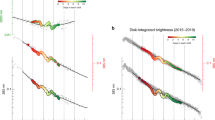Play all audios:

ABSTRACT THE evenings of January 2 and 3 were clear here, but the moon being full and near perigee, rendered invisible in the north-eastern sky all stars less bright than second magnitude. A
brief watch before midnight on January 2 indicated a total absence of meteors, and it was not thought advisable to prolong observations on this night, as it had been previously determined
by the writer that it was on the following night that the Quadrantid maximum would occur. Access through your institution Buy or subscribe This is a preview of subscription content, access
via your institution ACCESS OPTIONS Access through your institution Subscribe to this journal Receive 51 print issues and online access $199.00 per year only $3.90 per issue Learn more Buy
this article * Purchase on SpringerLink * Instant access to full article PDF Buy now Prices may be subject to local taxes which are calculated during checkout ADDITIONAL ACCESS OPTIONS: *
Log in * Learn about institutional subscriptions * Read our FAQs * Contact customer support SIMILAR CONTENT BEING VIEWED BY OTHERS BRIGHTNESS MODULATIONS OF OUR NEAREST TERRESTRIAL PLANET
VENUS REVEAL ATMOSPHERIC SUPER-ROTATION RATHER THAN SURFACE FEATURES Article Open access 12 November 2020 NIGHT-TIME MEASUREMENTS OF ASTRONOMICAL SEEING AT DOME A IN ANTARCTICA Article 29
July 2020 A SOLAR CYCLE CLOCK FOR EXTREME SPACE WEATHER Article Open access 08 April 2024 AUTHOR INFORMATION AUTHORS AND AFFILIATIONS * Dublin JOHN R. HENRY Authors * JOHN R. HENRY View
author publications You can also search for this author inPubMed Google Scholar RIGHTS AND PERMISSIONS Reprints and permissions ABOUT THIS ARTICLE CITE THIS ARTICLE HENRY, J. _The Quadrantid
Meteor Shower of 1904_ . _Nature_ 69, 272 (1904). https://doi.org/10.1038/069272a0 Download citation * Issue Date: 21 January 1904 * DOI: https://doi.org/10.1038/069272a0 SHARE THIS ARTICLE
Anyone you share the following link with will be able to read this content: Get shareable link Sorry, a shareable link is not currently available for this article. Copy to clipboard
Provided by the Springer Nature SharedIt content-sharing initiative
